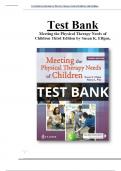, TEST yBANK yMeeting ythe yPhysical yTherapy yNeeds yof yChildren y3/E yEffgen, yFiss
Chapter y01. yServing ythe yNeeds yof yChildren yand yTheir yFamilies
Multiple yChoice
Identify ythe ychoice ythat ybest ycompletes ythe ystatement yor yanswers ythe yquestion.
y 1. According yto ythe yICF, yimpairments yare:
a. problems yin yfunctional yactivities.
b. restrictions yin yactivities.
c. problems yin yphysiological yfunctions yof ybody ysystems.
d. limitations yin yfunctional yskills.
e. limitations yin yparticipation.
y 2. Evidenced-based ypractice yshould yinclude:
a. expert yopinion, ycontinuing yeducation, yand ypersonal yexperience.
b. intuition, yunsystematic yclinical yexperience.
c. explanations ybased yon ypathophysiology.
d. awareness, yconsultation, yjudgment, yand ycreativity.
y 3. When ypossible, yan yexamination yshould:
a. start ywith ytests yand ymeasures yin ythe yclinical ysetting.
b. start ywith yobservation ydone yin ythe ynatural yenvironment ywhile ygathering yhistory.
c. never ybe ydone yin ythe ywaiting yroom.
d. start ywith ydetermining ythe ychild’s ystrengths yand yweaknesses.
y 4. When ydeveloping ythe yplan yof ycare yfor ya ychild, yit yis yimportant yto:
a. Determine ygoals yand yobjectives ybefore ytalking ywith ythe ychild yand yfamily.
b. Prescribe yinterventions yfocused yon ythe ychild’s yimpairments.
c. Ensure ygoals yand yinterventions yaddress yactivity yand yparticipation.
d. Focus yon ymeasurable ygoals yfor ythe ynext y2 yyears.
y 5. In ypediatric ypractice, ya ytop-down yapproach yto yassessment yis ypreferred ybecause:
a. weaknesses yare yidentified yfirst, yand yit yis ychild-centered.
b. desired youtcomes yare yidentified yfirst, yand yit yis yfamily-centered.
c. it yis ythe ymost ycommon ymodel yused yin yphysical ytherapy ypractice.
d. it yis ya ydeficit-driven ymodel.
y y y6. y Chaining ytechniques ywork ybest:
a. with ythose ywith ya ycognitive yimpairment.
b. as ynegative yreinforcement.
, c. as ycontinuous yreinforcement.
d. with ydiscrete ytasks yhaving ya yclear ybeginning yand yend.
y 7. Reinforcing ybehaviors/skills ythat yare yincreasingly ycloser yto ythe ydesired ybehavior/skill yare
ycalled:
a. negative yreinforcement.
b. behavioral yprogramming.
c. positive yreinforcement.
d. shaping.
y 8. Collaborative yteams:
a. desire yconsensus ydecision-making yin ydetermining ypriorities yfor ygoals
yandyobjectives.
b. provide yprofessionals ywith yautonomy.
c. discourage yrole yrelease ybecause yof yliability yissues.
d. prefer yto yprovide yintervention yin yspecial ytherapy yrooms.
e. tell yparents yexactly ywhat yto ydo yfor ytheir ychild.
y 9. Physical ytherapists yfirst ystarted yto ywork ywith ychildren:
a. in ythe y1940s yfor ythe ytreatment yof ychildren ywith ycerebral ypalsy.
b. when ySister yKenny ycame yto ythe yUnited yStates yto ymeet ythe yneeds yof
ychildren ywithypolio.
c. when yBerta yBobath yintroduced ya ytreatment yfor ychildren ywith ycerebral ypalsy.
d. during ythe ypolio yepidemic yin ythe yearly ypart yof ythe y20th ycentury.
y 10. y External yfactors ythat ymay yaffect ya ychild’s yfunction yinclude:
a. cognitive yability, yemotional ystability, ymotivation, yand ylanguage yability.
b. impairments yof ybody ystructures yand yfunctions yand ylimitations yin yactivities.
c. family ysupport, yaccess yto yhealth ycare, yfinancial yresources, yand yaccessible yschools.
d. family yand ychild’s ygoals yand yobjectives.
y 11. yIf yone yembraces ythe yICF ymodel, yno ymatter ywhat ysetting ya ypediatric ytherapist yis yproviding
yinterventions yin y(clinic, yschool, yhome, yetc.), ythe yprimary ylong-term ygoal yof yphysical
ytherapy yshouldybe yto:
a. maximize ythe ychild’s ystrength, yrange yof ymotion, yand yposture yin yorder yto
ypreventysecondary yimpairments.
b. minimize yall yphysical yimpairments yto yimprove ythe ychild’s ymotivation
yand yself-yconfidence ywhen yamong ypeers.
c. maximize ythe ychild’s yparticipation yin ythe yhome, yschool, yand ycommunity.
d. walk yup yand ydown ythe ystairs yindependently yin yless ythan y3 yminutes ywhile
ycarrying ytwo ytextbooks yin yorder yto ychange yclassrooms yin ythe ytime yallotted
ybetween yclasses.
e. eliminate yall yenvironmental yand ypersonal ybarriers yto ythe ychild’s ycommunity
, participation.
y 12. y A ytask yanalysis yincludes:
a. determining ythe yprerequisite ybody yfunctions.
b. the yactivities yrequired yto yperform ythe ytask.
c. the ycognitive yrequirements yto yperform ythe ytask.
d. understanding ythe ymotor yplanning yrequirements yof ythe ytask.
e. All yof ythe yabove
y 13. y The ysequence yof ythe yhierarchy yof yresponse ycompetence yis yfirst yskill yacquisition yfollowed yby:
a. fluency, ymaintenance, yand ygeneralization.
b. refinement yof ythe yskill, ytransfer, yand yattainment.
c. generalization, ymaintenance, yand yrefinement.
d. transfer yand yperformance yin ydifferent yenvironments.
y 14. y Which ymodel yof yteam yinteraction yis ymost ycommonly yused yin yearly yintervention yprograms?
a. Unidisciplinary ymodel
b. Multidisciplinary ymodel
c. Transdisciplinary ymodel
d. Hierarchical ymodel
y 15. yDetermining ythe yfrequency, yintensity, yand yduration yof yintervention yis ydifficult; yhowever,
ygeneralyguidelines yhave ybeen ydeveloped yfor:
a. cerebral ypalsy, ymyelomeningocele, yand ytraumatic ybrain yinjury.
b. pediatric yhospitals yand yschool-based ysettings.
c. outpatient yorthopedics yand yneonatal yintensive ycare yunits.
d. autism, yDown ysyndrome, yand ymuscular ydystrophy.
y 16. y Collaborative yteamwork ydoes ynot yinclude:
a. role yrelease yto ydesignated yteam ymembers.
b. consensus ydecision-making.
c. motor yand ycommunication yskills yembedded ythroughout ythe yinterventions.
d. professionals yworking yin yisolation yon ytheir yown.
e. equal yparticipation yon ythe yteam yby ythe yfamily.
y 17. y Which ystatement yleast yreflects ya yfamily-centered yphilosophy yof yphysical ytherapy yintervention?
a. Asking ythe yfamily ywhat ytheir yconcerns yare.
b. Providing ythe yfamily ya ydaily yhome yexercise yprogram yto yimprove ythe ychild’s
ymuscleystrength yin ypreparation yfor yambulation.
c. Identifying yfamily ycaregiving yroutines yand yproviding yconsultation yto yassist yfamily




